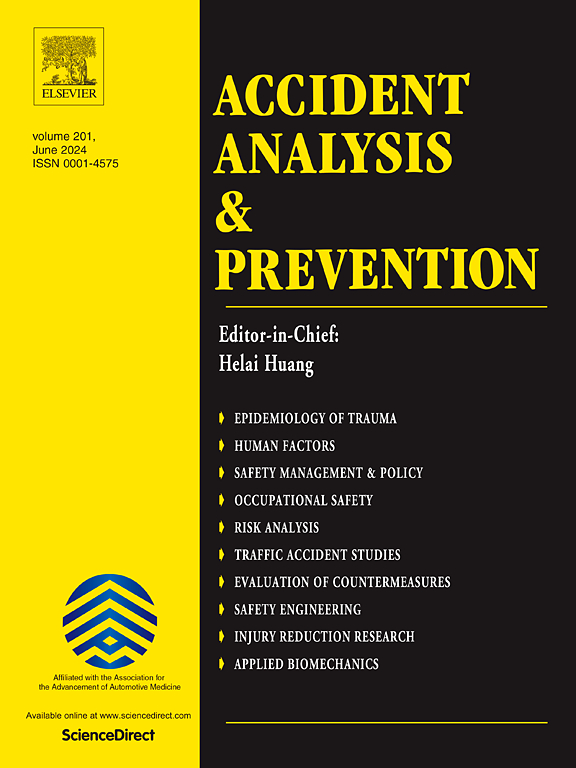Causal factors identification and dynamics simulation of major road traffic accidents from China’s evidence: A high-order mixed-method design
IF 5.7
1区 工程技术
Q1 ERGONOMICS
引用次数: 0
Abstract
Mitigating the injury and severity of road traffic accidents has become a crucial objective in global road safety efforts. Major road traffic accidents (MRTAs) pose significant challenges due to their high hazard and severe consequences. Despite their widespread impact, the complex causation mechanisms behind MRTAs have not been thoroughly and systematically investigated, which hinders the development of effective control strategies and policies. This study introduces an innovative high-order embedded mixed-method design to explore the causes of MRTAs, marking the first application of mixed-method approaches in road traffic accident research. The proposed approach consists of three phases: First, qualitative analysis utilizing grounded theory examines 95 MRTAs investigation reports to identify causal factors, establish a classification framework, and derive quantitative data. The second phase employs the decision experiment and evaluation laboratory (DEMATEL) for static quantitative analysis, quantifying interactions within the classification framework, and generating cause-effect diagrams. Finally, data and results from the first two phases are integrated to construct a system dynamics (SD) model and conduct sensitivity analysis, analyzing the impact of causal factors and their interactions on MRTAs casualties, thereby evaluating the effectiveness of various control strategies. The findings reveal that the causal factors of MRTAs can be categorized into five levels: “driver errors,” “vehicle, road and environment,” “supervisory deficiencies,” “organizational management and culture,” and “outside factors.” Complex interactions exist both among and within these levels, collectively influencing MRTAs. Moreover, in reducing MRTAs casualties, combined control strategies demonstrate significant superiority over single control strategies, especially when targeting key factors. It should also be noted that the importance ranking of causal factors dynamically adjusts with changes in the control environment, and the effectiveness of combined control strategies becomes more pronounced as the number of control factors increases. Specifically, comprehensive prevention strategies across all five levels exhibit the most remarkable efficacy. In conclusion, preventing MRTAs requires emphasizing the shared responsibility of all stakeholders and judiciously allocating control resources, while avoiding excessive reliance on interventions targeting any specific factor. This study provides a methodological foundation for a deeper understanding of the causation mechanisms behind MRTAs, and its results offer robust evidence to support the formulation of future prevention measures and policies.
基于中国证据的重大道路交通事故成因识别与动态模拟:一个高阶混合方法设计。
减轻道路交通事故的伤害和严重程度已成为全球道路安全努力的一个关键目标。重大道路交通事故因其危险性高、后果严重而构成重大挑战。尽管其影响广泛,但mrta背后复杂的因果机制尚未得到彻底和系统的调查,这阻碍了有效控制策略和政策的制定。本研究引入了一种创新的高阶嵌入式混合方法设计来探索mrta的原因,这标志着混合方法在道路交通事故研究中的首次应用。本文提出的方法包括三个阶段:首先,定性分析利用扎根理论对95份mrta调查报告进行分析,以确定原因,建立分类框架,并得出定量数据。第二阶段采用决策实验和评估实验室(DEMATEL)进行静态定量分析,量化分类框架内的相互作用,并生成因果关系图。最后,整合前两阶段的数据和结果,构建系统动力学(SD)模型并进行敏感性分析,分析原因因素及其相互作用对mrta伤亡的影响,从而评价各种控制策略的有效性。研究结果表明,交通事故的成因可分为“驾驶员失误”、“车辆、道路和环境”、“监管缺陷”、“组织管理和文化”以及“外部因素”五个层次。这些层次之间和内部存在复杂的相互作用,共同影响mrta。此外,在减少mrta伤亡方面,联合控制策略比单一控制策略具有显著优势,特别是在针对关键因素时。还需要注意的是,因果因素的重要性排序随着控制环境的变化而动态调整,组合控制策略的有效性随着控制因素数量的增加而更加明显。具体而言,所有五个层面的综合预防战略都表现出最显著的效果。总之,预防mrta需要强调所有利益相关者的共同责任,并明智地分配控制资源,同时避免过度依赖针对任何特定因素的干预措施。本研究为深入了解mrta背后的因果机制提供了方法学基础,其结果为支持未来预防措施和政策的制定提供了有力的证据。
本文章由计算机程序翻译,如有差异,请以英文原文为准。
求助全文
约1分钟内获得全文
求助全文
来源期刊

Accident; analysis and prevention
Multiple-
CiteScore
11.90
自引率
16.90%
发文量
264
审稿时长
48 days
期刊介绍:
Accident Analysis & Prevention provides wide coverage of the general areas relating to accidental injury and damage, including the pre-injury and immediate post-injury phases. Published papers deal with medical, legal, economic, educational, behavioral, theoretical or empirical aspects of transportation accidents, as well as with accidents at other sites. Selected topics within the scope of the Journal may include: studies of human, environmental and vehicular factors influencing the occurrence, type and severity of accidents and injury; the design, implementation and evaluation of countermeasures; biomechanics of impact and human tolerance limits to injury; modelling and statistical analysis of accident data; policy, planning and decision-making in safety.
 求助内容:
求助内容: 应助结果提醒方式:
应助结果提醒方式:


